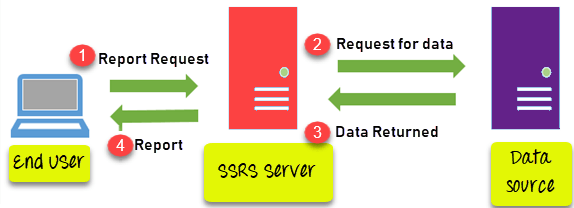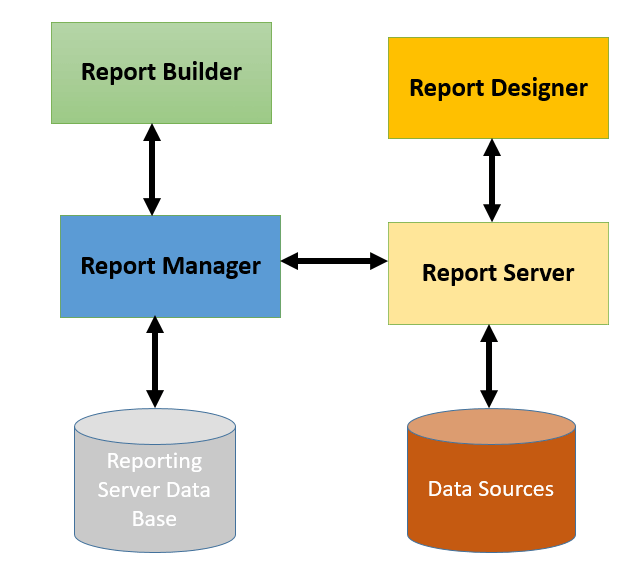PL-SQL
Oracle PL/SQL Records Type with Examples
What is Record Type? A Record type is a complex data type which allows the programmer to create a...
SQL Server Reporting Services (SSRS) is a reporting software that allows you to produce formatted reports with tables in the form of data, graph, images, and charts. These reports are hosted on a server that can be executed any time using parameters defined by the users. It is part of Microsoft SQL Server Services suite.
In this SSRS tutorial, you will learn
Three types of SSRS reporting services are:
Here, are prime reasons for using SSRS tool:

Consider a SSRS report example of a medical research institute where patients are recruited for various clinical trials.
The staff in the institute creates a database record for each patient.
Once they agree to be part of the trial, and the hospital gets the payment form the drug company based on the price at which it is ready to participate.
Without SSRS, the medical institute would need to manually email a report to the pharma company with the total number of weekly participants. The institute must also add details of every patient included in the trial, the number of drugs used, and all the unwanted situations. As a result, the time taken to collect and send this data in the correct format may consume loads of valuable time in the clinic.
If the institute were recording data, with the help of SSRS tool, they would be able to produce on-demand reports in a pre-defined format.
With SSRS, the drug company can access the report on the cloud, run the report at any time to get the latest data from the clinic.
Now in this SSRS tutorial, we will learn how SSRS works: 

SSRS has quite a complex architecture. The report services architecture includes development tools, administration tools, and report viewers.
Here, are important components of SSRS
It is an ad-hoc report publishing tool that is executed on a client's computer. It has a drag and drop interface that is easy to use.
The Report designer tool helps to develop all types of reports. It is a publishing tool, that is hosted in Visual Studio or Business Intelligence Development Studio (BIDS).
The report managers check the report, matching it with the given requirements. They make decisions based on those reports.
It is a server which uses the SQL Server database engine to store metadata information
It stores metadata, report definitions, resources, security settings, delivery data, etc.
Reporting services retrieve data from data sources like relational and multidimensional data sources.
Every organization follows a standard reporting lifecycle which can be classified as follows:
Authoring: In this phase, the report author defines the layout and syntax of the data. The tools used in this process are the SQL Server Development Studio and SSRS tool.
Management: This phase involves managing a published report which is mostly part of the websites. In this stage, you need to consider access control over report execution.
Delivery: In this phase, you need to understand when the reports need to be delivered to the customer base. Delivery can be on-demand or pre-defined schedule. You can also add an automation feature of subscription which creates reports and sends to the customer automatically.
Report Definition Language is shortly known as RDL. It describes all possible elements of a report using an XML grammar which is validated by an XML schema.
The report definition of an individual report is based on RDL. It contains instructions for rendering the design of the report at the run time.
Here, are types of reports which you can develop using SSRS tool.
| Report Type Name | Detail |
| Parameterized reports | This type of report uses input values to complete report or data processing. |
| Linked Reports | A linked report offers a point to an existing report. This type of report is derived from an existing report and retains the original's report definition. |
| Snapshot reports | A snapshot report contains layout information and query results which can be retrieved at a specific point in time. |
| Cached Reports | The cashed report allows you to create a copy of the processed reports. They are used to enhance the performance by reducing the number of processing requests and time to retrieve large reports. |
| Drill down Reports | Drill down reports helps you to hide complexity. It allows users toggle between hidden reports items to control how much detail data you want to see. It must retrieve all possible information that can be shown in the report. |
| Drillthrough Reports | Drillthrough reports are standard reports which can be accessed through a hyperlink on a text box in the original report. It works with the main report and is the target of a drill through an action for a report item like a placeholder text or a chart. |
| Subreports | As the name suggests, sub-reports is a report which displays another report inside the body of the main report. |
Some limitations of SSRS are given below:
What is Record Type? A Record type is a complex data type which allows the programmer to create a...
What are views? VIEWS are virtual tables that do not store any data of their own but display data...
What is the UPDATE Query? UPDATE MySQL command is used to modify rows in a table. The update...
SQLite supports different types of SQL Joins, like INNER JOIN, LEFT OUTER JOIN, and CROSS JOIN....
In this article, we will see how to create tables, modify tables and dropping tables in SQLite3...
{loadposition top-ads-automation-testing-tools} There are many SQL management tools available in...